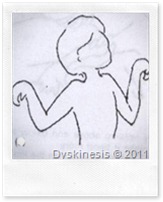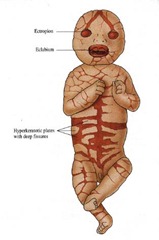Hematidrosis
Who says women only sweat…well that, sweat? People have always find themselves being curious about menstruation, because indeed, this isn’t normal for many people, in ancient cultures, they were afraid of women who were menstruating, because they used to say that everything they touch would be impure, the grass would whiter away, and many things like that.
I think most of us know that menstruation is nothing but to get rid of the endometrium because there was no pregnancy. The uterus is composed of three layers, the outermost is the perimetrium, the middle layer is the myometrium and the innermost layer: the endometrium.
Each month, the endometrium grows (endometrial hyperplasia) to be prepared to receive the fertilized egg and to begin its maturation, but if this doesn’t happen, then the endometrium is disposed by way of menstruation, by the vaginal conduct.
Now, let’s talk about the anomaly, Dr. Lhéritier wrote once about a young girl who suffered from suppression of menses1, which, instead of flowing through the natural channels, issued perodically from vesicles on the leg, for 6 months, then the seat of discharge changed to an eruption of the left arm, for a year, and then it changed again and again, until it arrived to the upper eyelid, here it continued for a period of two years.
 Now this isn’t all, what about Dr. Haller, who claims to have met 18 women who menstruated from the skin. And Dr. Parrot confirmed the existence of these cases. I’d like to share the story of Dr. Chambers, who speaks of bloody sweat occurring periodically in a woman of twenty-seven years. The intervals, however, were occasionally but a week or a fortnight, and the exudation wasn’t confined to any one locality.
Now this isn’t all, what about Dr. Haller, who claims to have met 18 women who menstruated from the skin. And Dr. Parrot confirmed the existence of these cases. I’d like to share the story of Dr. Chambers, who speaks of bloody sweat occurring periodically in a woman of twenty-seven years. The intervals, however, were occasionally but a week or a fortnight, and the exudation wasn’t confined to any one locality.
Dr. D´Andradé tells us about a healthy Parsee lady, 18 years old, who menstruated regularly from 13 to 15 years; the catamenia2 then became irregular and she started suffering occasional hemorrhages from the gums and nose, together with attacks of hematemesis3. The menstruation returned to normal, but she never became pregnant, and later, blood issued from the healthy skin of the left breast and right forearm, recurring every month or two, and finally additional dermal hemorrhage developed on the forehead.
 Microscopic evaluation of the exuded blood showed usual components present. There are two somewhat similar cases spoken in French literature, for example, the first was that of a young lady, who after ten years’ suppression of the menstrual discharge, exhibited the flow from a vesicular eruption of the finger, and the other case was quite peculiar, the woman being a prostitute, who menstruated from time to time through spots, the size of a silver dollar, developing on the breast, buttocks, back, axilla, and epigastrium.
Microscopic evaluation of the exuded blood showed usual components present. There are two somewhat similar cases spoken in French literature, for example, the first was that of a young lady, who after ten years’ suppression of the menstrual discharge, exhibited the flow from a vesicular eruption of the finger, and the other case was quite peculiar, the woman being a prostitute, who menstruated from time to time through spots, the size of a silver dollar, developing on the breast, buttocks, back, axilla, and epigastrium.
There are many cases like these around the world, I’m telling you about just a few of them, some people would even say that sweating blood is demoniac, some of them may even bleed through the eyes. This is just an anomaly of the human body, nothing to be scared of.
1- Menses is the monthly flow of blood and cellular debris from the uterus that begins at puberty and ceases at menopause.
2- Catamenia (menses) A term used frequently to designate age at onset of menses.
3- Hematemesis is the vomiting of blood. The source is generally the upper gastrointestinal tract.
Urethral Foreign Visitors
The bladder has being known for developing calculus, but some of those times, the calculus were caused by none other than the person who has them. How can foreign objects be introduced into one’s bladder? They generally gain entrance through one of the natural passages, as a rule being introduced, either by curiosity or for perverted satisfaction, or sometimes because it helped with a disease.
Once, a doctor mentioned something about a long wax taper (a candle) that was introduced into the bladder through the urethra of a man, at the University Hospital, Philadelphia, by median cystotomy1, a long wax taper was extracted, it is said that it was used for masturbation. Another case is known about a 35 year-old man who practiced urethral masturbation with the tail of a squirrel, and 3 caudal vertebraes from the animal were found in the center of a vesical calculus taken from the bladder.
But this matter seems to be more common on women, the urethra of the females is short and dilatable, it’s about 1.5-2 inches long, but that doesn’t keep foreign bodies to be found inside the bladder.
In January 24th of 1874, Doctor Whiteside described a case in which a foreign body introduced into the bladder was mistaken for pregnancy. The girl was 17 years-old and she had missed several times her menstruation, the symptoms where there, nausea, vomits, tender and voluminous breasts, and the nipples were surrounded by a somber areola, also the abdomen was more developed than usual. After periods of cessation of menstruation, she started having incontinence of urine, the urine also had disagreeable odor and it was high on albumino us, specific gravity, and alkaline. In spite of all the symptoms the uterus wasn’t having any augmentation in the size, then the doctor recurred to the introduction of a catheter and it showed the existence of a large calculus, after surgery the calculus was put under chloroform and it came to be the handle of a tooth-brush (shown figure 2), at first the young woman would give no explanation for its presence, but then she explained that she had been using it for relief in retention of urine, so one day it must’ve fallen into the bladder.
us, specific gravity, and alkaline. In spite of all the symptoms the uterus wasn’t having any augmentation in the size, then the doctor recurred to the introduction of a catheter and it showed the existence of a large calculus, after surgery the calculus was put under chloroform and it came to be the handle of a tooth-brush (shown figure 2), at first the young woman would give no explanation for its presence, but then she explained that she had been using it for relief in retention of urine, so one day it must’ve fallen into the bladder.
 Another report show the case of a woman who habitually introduced hair-pins into her bladder, she did this in attempt at dilatation of the urethra in the relief of a case of strangury2. Sometimes, UTI’s (Urinary Tract Infections) if not treated, they tend to be quite dangerous, let’s look at this curious case, a woman introduced a hog’s penis (also known as pig’s penis) into her urethra. It was removed by an incision into this canal, but then the patient suffered septicemia3 and died. Septicemia can be developed after an infection, but specially in the urethra, it is a grave infection and it is potentially deadly, it gets worse very quickly and it can surge from infections all over the body, including pulmonary infections, abdomen etc. UTI’s can also cause pyelonephritis4.
Another report show the case of a woman who habitually introduced hair-pins into her bladder, she did this in attempt at dilatation of the urethra in the relief of a case of strangury2. Sometimes, UTI’s (Urinary Tract Infections) if not treated, they tend to be quite dangerous, let’s look at this curious case, a woman introduced a hog’s penis (also known as pig’s penis) into her urethra. It was removed by an incision into this canal, but then the patient suffered septicemia3 and died. Septicemia can be developed after an infection, but specially in the urethra, it is a grave infection and it is potentially deadly, it gets worse very quickly and it can surge from infections all over the body, including pulmonary infections, abdomen etc. UTI’s can also cause pyelonephritis4.
So please, we’ve come to the conclusion that urethras are for expulsing urine, and no more. You cannot introduce any type of thing, and if you still want to, be careful, you don’t want to appear in any of these stories, or do you?. After a foreign object has been introduced into the urethra it is very possible to be slipped into the bladder and cause a calculus and/or infection. The calculus is formed because bladder may cover the object with calcareous deposits or be covered by mucus and folds of the bladder.
1- Cystotomy is the surgical removal of a stone in the urinary bladder.
2– Strangury is the symptom of painful, frequent urination of small volumes that are expelled slowly only by straining and despite a severe sense of urgency.
3– Septicemia is the presence of bacteria in the bloodstream (also known as bacteriemia) and it tends to be associated with grave infections.
4– Pyelonephritis is a kidney infection. It is usually bacterial in origin and stems from an infection in another part of the urinary tract, such as the bladder.
Athetosis
This disease was discovered in first place by a guy named Hammond in 1871, it is mainly about people who don’t like to have the toes and fingers in any place or position in which they might be planed, as well as their continuous motion. 
This is because these people who have Athetosis also have a cerebral affection, they present a combination of symptoms which are characterized by a –more or less- constant mobility of the extremities and they also have the inability to retain them in any fixed position. This could be one of the most uncomfortable diseases I’ve ever known about.
The movements tend to be involuntary and turn out to be morbid or even grotesque, they are somehow regular and rigid, they don’t seem to be jerky or spasmodic. Now the movement of the digits are a bit different from those attending any other disease, they are impossible to imitate even by the most skilful malingerer and if you could see them, you wouldn’t forget them easily.
 In an athetoid hand, the interossei and lumbricales, wich are used to flex the metacarpo-phalangeal and to extend the phalangeal joints, are affected, but there are these rare cases in which the long extensors and flexors are affected. This means that the hand will be in the interosseal position, in other words, the hand will seem contracted. The movements of the toes depend to those of the fingers in point of action.
In an athetoid hand, the interossei and lumbricales, wich are used to flex the metacarpo-phalangeal and to extend the phalangeal joints, are affected, but there are these rare cases in which the long extensors and flexors are affected. This means that the hand will be in the interosseal position, in other words, the hand will seem contracted. The movements of the toes depend to those of the fingers in point of action.
The disease could be confined to one side –hemiathetosis- and is a sequel of hemiplegia1 . The differential diagnosis is easily made, because the only affections which we could possibly confounded with are chorea2 and paralysis agitans3.
The following is a case regarding a quadruple athetosis, associated with epilepsy and insanity. The patient was an afroamerican woman, 26 years old and was mother of 1 child, in 1886. She had had epilepsy of the grand mal type4 for many years. She continued to have epilepsy and ultimately it lead to a degenerated state of almost absolute imbecility.
 The experts tend to say that some degree of mental deficiency is usually related to athetosis, even when uncomplicated by any other degenerating neurosis. For this woman was impossible to track the beginning of her symptoms, she was admitted into the hospital with affections to her extremities, both lower and upper. She never had any attack of apoplexy nor paralysis and she seemed perfectly normal, but her pedal extremities involuntarily assumed various distorted positions and were constantly moving. The feet were moved upon the ankles in a stiff and awkward manner and the muscles became hard and rigid. She died in January 1895, after an obstinate attack of status epilepticus.
The experts tend to say that some degree of mental deficiency is usually related to athetosis, even when uncomplicated by any other degenerating neurosis. For this woman was impossible to track the beginning of her symptoms, she was admitted into the hospital with affections to her extremities, both lower and upper. She never had any attack of apoplexy nor paralysis and she seemed perfectly normal, but her pedal extremities involuntarily assumed various distorted positions and were constantly moving. The feet were moved upon the ankles in a stiff and awkward manner and the muscles became hard and rigid. She died in January 1895, after an obstinate attack of status epilepticus.
To this people, the act of walking became considerably difficult because of contractures and also because the feet were not exactly under the control of the will. Their health is fairly good, sometimes they are irritable and violent so their athetoid movements are intensified.
The treatment for this disease depends on the goal, and the kind of patient, cause some may be too young or small, some of them could be treated by oral medications – like Primidone – or intramuscular injections, but for the adults the surgical treatment could be recommended. Occasionally, it is not clear which treatment would be the most appropriate.
1- Hemiplegia is total paralysis of the arm, leg, and trunk on the same side of the body.
2– Chorea is an abnormal involuntary movement disorder, one of a group of neurological disorders called dyskinesias.
3– Paralysis Agitans also called Parkinson’s disease is a disorder of the brain that leads to shaking and difficulty with walking, movement, and coordination.
4– Grand mal seizure features a loss of consciousness and violent muscle contractions and affects the entire brain.
Harlequin Babies
Have you ever heard of the “Harlequin Syndrome”? Well, this is about a skin disease, the papilla on the skin grows abnormally, kinda like scales on a fish. This is because the epithelium grows thick and hard, so it seems like skin has a bunch of bumps on it, the disease is congenital (exists from birth).
Do you remember the famous “Porcupine-Man” back in 1710 who displayed himself in England? this man had Ichthyosis hystrix which is the formal name for this disease, his skin used to be so thick that maybe he would compete with a crocodile. His whole skin (except from his face, the soles on his feet, and the palms of his hands) was covered with small scales. The scales used to be so hard and elastic that when he rubbed his hand against his arm (or another part of his body) it would make a horrible noise.
Apart from that, the man had 6 children who proudly wore the same scales as their father. So he had what we would call a “normal” life.
There was another case, in which a man had the same disease in his entire body except from the parts that had too much friction, so they were worn off. His great grandfather and another 4 generations had this condition but, the rare thing about this is that none of the females had it, actually they had a very normal skin. This man was called “The biped armadillo” because his skin used to look like he had spines, so this is a variation of Ichthyosis.
 So, getting back to the “Porcupine-Man”, he contracted small-pox and the squamous were temporarily worn off, but they reappeared in no time. And this isn’t all! There was also an “Alligator-boy”, another type of Ichthyosis, his skin was covered with thick hairs like the bristles of a boar, and sometimes they would turn kind of greenish.
So, getting back to the “Porcupine-Man”, he contracted small-pox and the squamous were temporarily worn off, but they reappeared in no time. And this isn’t all! There was also an “Alligator-boy”, another type of Ichthyosis, his skin was covered with thick hairs like the bristles of a boar, and sometimes they would turn kind of greenish.
But this isn’t what I’ve been wanting to tell you about, I want you to meet the Harlequin babies, they are a result from the Ichthyosis congenita, a very specific type of disease, these babies in the moment they are born, they are covered in some kind of fatty epidermal plates and they have vertical and horizontal fissures, they look like a shattered rock, after birth this fissures may move and it causes a lot of pain.
The skin is so stiff that they cannot completely open or close their eyes, and they can barely move. If these babies are not born dead, they may die from starvation (they cannot open their mouths either) or loss of heat, but if the disease isn’t too severe they may actually survive.
The treatment for this disease is ACITRETIN administered for 6 months with the supervision of a doctor. There are no side effects, and is by oral treatment.
Vomiting Urine
Writing is just like vomiting…. what was once on the inside, it’s now on the outside.
Many old writers have mentioned different modes of exit of the urine, such as nipples, eyes and mouth. Some people think that vomiting urine is impossible, because as we know, urine is produced in the nephrons and they each contain a glomerulus which is the main filter of the nephron, each kidney has over a million glomerulus, so to vomit urine it would have to pass through the glomerulus of the kidneys then through your blood stream and find a way into your stomach to be vomited.
Well, this IS possible.
In Germany there was a case of Dysuria (painful urination) in which the woman would discharge urine from the stomach, she would feel the accumulation of urine by a burning pain in the epigastrium, then that pain would travel to the soles of the feet, and she would become nauseated and finally vomit large quantities of urine.
A case of Ischuria (lack of ability to urinate) turned out to be one of the best examples for this anomaly, another woman had ischuria for more than 3 years so the urine was extracted with a catheter and if it wasn’t like that, she would voided it by vomiting. This woman later developed a gravel urine, there are many causes for this, this is how it works, there are different chemicals, such as phosphates, oxalates, urates or cysteine crystals that crystallize and settle from urine when it stands in a container. Urate can be obtained from fresh animal meat, they are high in uric acid which is a precursor of urate production in the body.
 Also, the parathyroid glands, if overactive can cause calcium stones, because they regulate the calcium and phosphorus, or even ingesting too much milk. As this woman continued to have gravel in her urine the use of the catheter was suspended so she started to vomit urine and gravel. But as the doctors noticed that this vomit contained urea and the properties of urine they developed a cure, they did a ligature of the superior thyroid arteries and sloughing of the thyroid gland. The woman never vomited urine again.
Also, the parathyroid glands, if overactive can cause calcium stones, because they regulate the calcium and phosphorus, or even ingesting too much milk. As this woman continued to have gravel in her urine the use of the catheter was suspended so she started to vomit urine and gravel. But as the doctors noticed that this vomit contained urea and the properties of urine they developed a cure, they did a ligature of the superior thyroid arteries and sloughing of the thyroid gland. The woman never vomited urine again.

